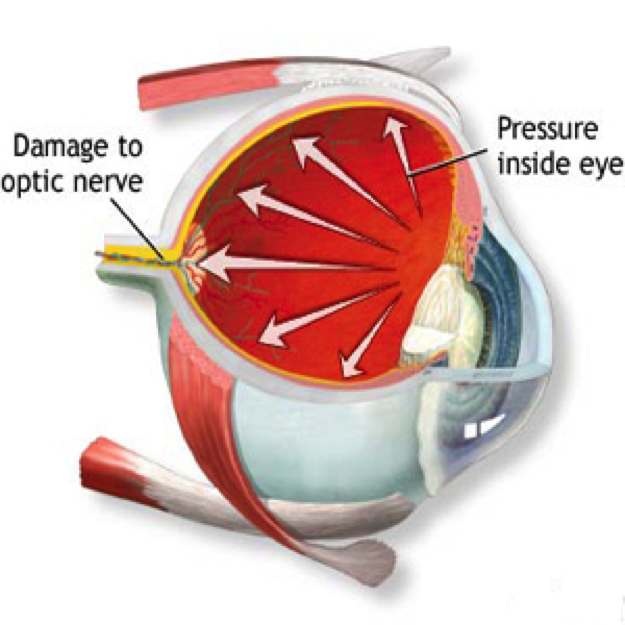Glaucoma is a group of eye diseases characterized by damage to the optic nerve usually due to excessively high intraocular pressure(IOP).This increased pressure within the eye, if untreated can lead to optic nerve damage resulting in progressive, permanent visionloss, and lead to blindness.
Glaucoma is one of the leading causes of blindness in the worldwide, especially in Asia. Glaucoma can damage your vision so gradually you may not notice any loss of vision until the disease is at an advanced stage.
Symptoms
The most common types of glaucoma - primary open-angle glaucoma and angle-closure glaucoma - have completely different symptoms.Primary open-angle glaucoma signs and symptoms include:
POAG :
- Gradual loss of peripheral vision, usually in both eyes
- Tunnel vision in the advanced stages
PACG (accute type) :
- Eye pain
- Nausea and vomiting (accompanying the severe eye pain)
- Blurred vision
- Halos around lights
- Reddening of the eye
Both open-angle and angle-closure glaucoma can be primary or secondary conditions. They're called primary when the cause is unknown and secondary when the condition can be traced to a known cause, such as eye injury, medications, inflammation, tumor, advanced cataract or diabetes.
Similarly, congenital glaucoma is evident at birth. Symptoms are bulging eyes, cloudy corneas, excessive tearing, and sensitivity to light.
Risk Factors
Because chronic forms of glaucoma can destroy vision before any signs or symptoms are apparent, be aware of these factors:
- Elevated internal eye pressure (intraocular pressure).
If your internal eye pressure (intraocular pressure) is higher than normal, you're at increased risk of developing glaucoma, though not everyone with elevated intraocular pressure develops the disease. - Age
You're at a higher risk of glaucoma if you're older than age 40. For certain groups such as African-Americans, however, the risk of developing glaucoma is much higher and occurs at a younger age than that of other groups. - Ethnic background
African-Americans older than age 40 have much higher risk of developing glaucoma than do whites (Caucasians). People of Asian descent have an increased risk of developing acute angle-closure glaucoma. - Family history of glaucoma
If you have a family history of glaucoma, you have a greater risk of developing it. - Medical conditions
Several conditions may increase your risk of developing glaucoma, including diabetes, heart diseases, high blood pressure and hypothyroidism. - Other eye conditions
Severe eye injuries can cause increased eye pressure. Other eye conditions that could cause increased risk of glaucoma include eye tumors, retinal detachment, eye inflammation and lens dislocation. Also, being nearsighted or farsighted may increase your risk of developing glaucoma. - Long-term corticosteroid use
Using corticosteroid medications, especially eyedrops for a long period of time may increase your risk of developing secondary glaucoma.
Diagnosis
Intraocular pressure, visual field defects, the angle in the eye where the iris meets the cornea, and the appearance of the optic nerve areall considered in the diagnosis of glaucoma.


Treatment
The goal of glaucoma treatment is to lower pressure in your eye (intraocular pressure). Glaucoma can't be cured, and damage caused by the disease can't be reversed. However, treatment and regular checkups can prevent vision loss in people with early glaucoma.
Medications
When glaucoma is diagnosed, drugs, typically given as eye drops, are usually tried before surgery. Several classes of medications areeffective at lowering IOP by inhibiting the production and increasing the outflow of aqueous humor.
Surgery
Laser
There are several types laserto treat glaucoma. Laser peripheral iridotomy makes an opening in the iris allowing thefluid to drain, argon laser trabeculoplasty is aimed at the fluid channel opening to help the drainage system function and lasercyclophotocoagulation is used to decrease the amount of fluid made.

Filtering Surgery
If eyedrops and laser surgery aren't effective in controlling your eye pressure, trabeculectomy should be considered.In trabeculectomy, surgeon creates an opening in the sclera so fluid can drain from and move freely leave the eye through this opening. As a result, your eye pressure will be lowered.

Drainage Implants
Some people with advanced glaucoma, secondary glaucoma or children with glaucoma may be eligible for drainage implants. In this procedure, your eye surgeon inserts a small tube in your eye to facilitate draining fluid (aqueous humor) from your eye to reduce the pressure.

Prevention
Because glaucoma may not initially result in symptoms, the best form of prevention is to have regular eye exams.



 INA
INA